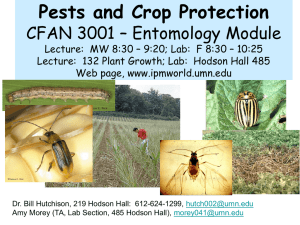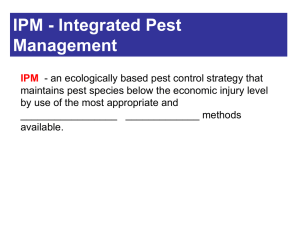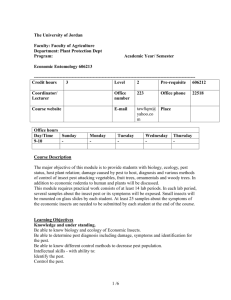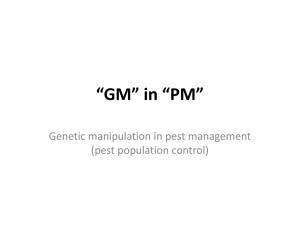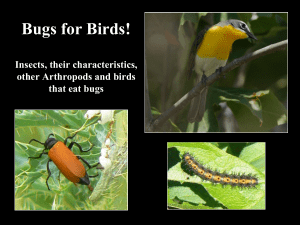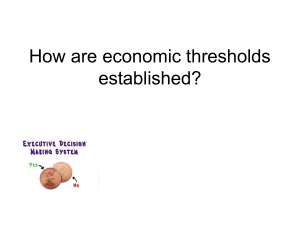KULIAH DSR PERLINTAN
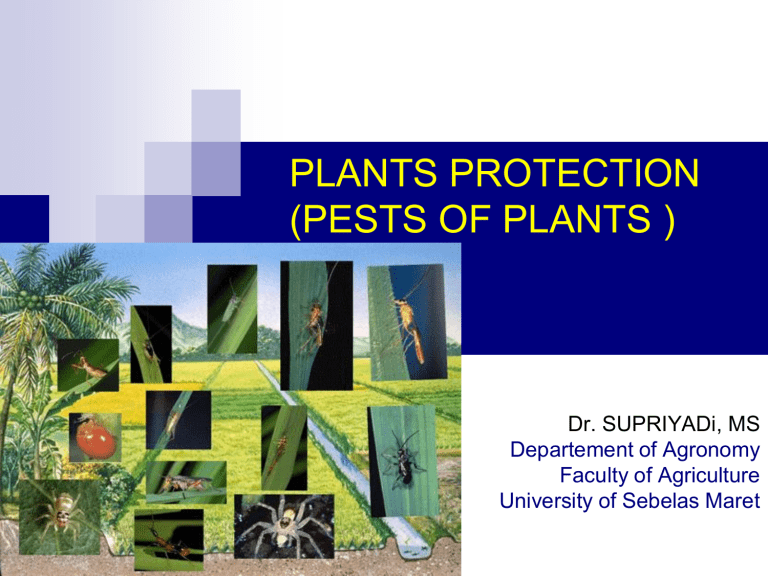
PLANTS PROTECTION
(PESTS OF PLANTS )
Dr. SUPRIYADi, MS
Departement of Agronomy
Faculty of Agriculture
University of Sebelas Maret
I. Introduction
Lecture Schedule
Introduction
Insects as Pests (Identified of insect)
Insect Ecology
Pest controls
Integrated pest management
ASSESMENT: MIDTERM
Reference
Wilson MC, Broersama DB & Provonsha AV. 1083.
Fundamentals of Aplied Entomology. 2nd. Practical
Insect Pest Management Vol 1. Perdue University
Kalshoven LGE. 1981. Pests of Crops in Indonesia.
sed by PAVan der Laan. PT. Ichtiar Baru. Jakarta
Borror DJ, De Long DM, and Triplehorn CA. 1981. An
Introduction to the study of insects. Saunder Collage
Publishing. Philadelphia. 827p.
Animals as Pest
In agricultural context : pest can be defined that animals cause sufficient damage in terms of reduction of yield and the quality of the harvested product by an amount that is unacceptable to the farme r.
Relatively few species of animals compate with man while feeding, these few often onlyattain pest status because man has cultivated crops which are their preferred hosts.
The great majority of animals including insects, are, however, harmless or even useful
The Number and Proportions of species in major taxa species
Protozoa; 30000; 2%
Vertebrates; 54000; 4%
Other Invertebrates
213000
15%
Saprophagous and
Predacious Insects; 431000;
31%
Green Plants ; 308000; 22%
Phytophagous Insects;
361000; 26%
Green Plants
Phytophagous Insects
Saprophagous and Predacious Insects
Other Invertebrates
Protozoa
Vertebrates
( Southwood, 1978 )
Groups of animals
Goups of animals as Pest
Phyillum Arthropoda
Clas of Insecta (e.g brwn planthopper, Nilaparvata lugens)
Clas Arachnid (Acarina: e.g Teranychus spp)
Phyillum Chordata
Clas Mammalia (Rodentia: e.g. Callosciurus sp, Rattus rattus diardii .
Clas Aves (Birds: e.g. Munia spp.)
Phyillum Mollusca
Klas Gastropodag (e.g. giant snail (Achatina fulica)
Phyillum Nemathelmintes :
Klas Nematoda (e.g Rootknot nematode, Meloidogyne spp)
The importance of Insect as pests……..
???
Phyillum Chordata
Phyillum Mollusca
Phyillum Chordata
Phyillum Insecta
The importance of
Insect as pests
Why are insects impotant as pest
Live in the greatest variety of habitats
Exhibit diverse types of locomotion
Eat the greatest variety of food
(monophagous, olygophagous, polyphagous)
Greatest number of species
Hight facundity or progeny
Comparative number of described animals species.
Crustacea
3% other inverterbrata
2%
Arachnida
4%
Protozoa
4% worm
2%
Myriapoda
1%
Other Insect
9%
Vertebrata
6%
Hemiptera
8%
Coleoptera
42%
Coleoptera
Mollusca
Diptera
Hemiptera
Vertebrata
Other Insect
Protozoa
Arachnida
Crustacea other inverterbrata worm
Myriapoda
Diptera
9%
Mollusca
10%
( Southwood, 1978 )
INSECT
INTERACT
WITH
BENEFICIAL HARMFUL
MAN
PLANTS
OTHER ANIMALS
BENEFICIAL TO
MAN THEY COMPETE
WITH MAN
BENEFICIAL INSECT
Dactylopius coccus
(Hemiptera:Coddoideae )
Honey bee,
Aphis mellifera
Insect Pollinators
- (Apis sp)
Natural enemies:
-Predators
14
Natural enemies:
-Parasitoids
15
Natural enemies:
-Parasitoid
16
I. Insect as Pests
Causes of Pest Occurrences and Outbreak
Monoculture of crops.
A Large concentration of the same species cultured year after year will provide of resources for insect feeding, and so the ecological diversity is nonexistent.
A situation analogous to storage of food.
Crops are introduced to new biotic communities without accompaniment of their natural enemies
Breeding of susceptible genotype of crops when in search of other attributs (e.g. yield, flavours, quality, resistance to climats and other conditions )
Causes of Pest Occurrences and Outbreak
Application of broad spectrum insecticide ca eliminate benefecial insects (predators and parasitoids and competitors of pest species), in general so that secondary pest outbreak emerge.
Or to lead of an insecticide resistant strain
Use of nitrogen fertilizer in high levels may also generate rapid increase in insect pest number
Insect are able to increase in numbers rapidly because of their very high reproductive potentials .
Periodical or cyclical pest outbreak can occur even under natural conditions ( e.g Locust, plant/leaf hopper, noctuid)
PLANT-FEEDING
INSECT
Damage: damage causing insect may be classified as follows:
Defoliators: leaf eater dan leaf miner
Borers or feeders: of steams, roots, fruit, and seed
Root feeder
Sap feeder
Gall former
Those which do multiple damage.
Pest of stored product
Defoliators: leaf eater dan leaf miner
As rule these cause the most conspicuous damage (couse kill seedling or small plant).
E.g: Locusta spp (Orthoptera); the army worm:
Spodoptera spp (Lepidoptera),
Tipe of Mouthparts: mandibulata
Cabbage Looper
Trichoplusia ni (Hubner)
Larva have 5 instars in 3 weeks, most damage is done in last 2 instars adult
Eggs hatch in 3-4 days
As a pupa for about 2 weeks
Borers or feeders: of steams, roots, fruit, and seed
Boring insects largely occur in the orders
Lepidoptera, Diptera, Coleoptera, Isoptera.
E.g Fruit flies, Dacus spp. (Diptera), Rice stem borer, Tryporyza sp. Corn borer, Sitophyllus sp
Root feeder
Damage: damage causing insect may be classified as follows:
Root feeder potato moth, Phthorimaea operculella.
Sap feeder
Damage caused are two types: direct damege and indirect damage, as follows:
Direct damage: Caused by stylets damaging cell of the plant, particularly of the soft growing tissue. Symptoms are Necrotic spot, stunting and phytotoxemia/ discolouration
Indirect damege: Caused by insects acting as vectors of virus or mycoplasma disease. The typemof damege maybe more serious than direct damge
Aphid on chili
Kutu kebul (Bemisia tabaci)
green peach
Aphids on some plants
foxglove melon
Tungro virus on Rice
Bacilliform virus particles of Rice tungro bacilliform virus (Courtesy H. Hibino)
The symtom of rice tungro virus in rice field
Gall former
Gall forming insect are found in the orders of
Diptera, Hemiptera.
These insects produce galls on plant tissue .
E.g Rice Gall midges, Orseolia oryzae; Gall forming pest of young tobacco,
Scrobipalpa heliopa,
Multiple damage
There are pests that cause multiple damage that combine some of the catagories of damage reffered to above:
E.g.
The caterpillar as known of catton bollworm, tobacco budworm, Heliothis armigera and H.puctigera. These catterpillar caused seriuous damage on vgetable and horticultural crops.
Pest of Stored
Product
Pest of stored product or post harvest pest generally belong to orders of Lepidoptera and
Coleoptera. Grain and grain product are subject to damage by the insect. Losses are felt in two ways (i) loss fo grain itself and (ii) presence of insects makes grains ang grains products unsuitable for consumption
E.g. Rice weevil, Sitophyllus spp, Flour beetle,
Tribolium spp.
BUKU ACUAN
Buku Acuan
:
Kalshoven LGE. 1981. Pests of Crops in Indonesia.
Terjemahan Van der Laan. PT. Ichtiar Baru. Jakarta
Metcalf,R L dan W.H. Luckman. 1975. Intoduction of Insect
Pest Management. John Willy Publisher. New York
Borror,Dj; D.M. DeLong; dan C.A. Triplehorn. 1981. An
Introduction to the Study of insect. Saunder Collage
Publishing. Philadelphia.
Chapman, RF. 1975. The Insect, Structure And Function.
American Elsivier Publishing Company Inc. New York
